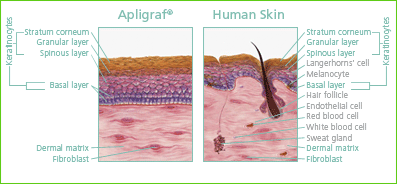
A diagram illustrating the similarities of Apligraf® to human skin, produced by the Organogenesis website.

A 20-year-old Luke Massella, pictured here in March 2011 as part of Dr. Anthony Atala's TED presentation "Printing a Human Kidney"
Lab Grown Organs
A Powerful Solution to a Desperate Problem: Lab Grown Organs
With the huge organ donor shortage, these organs made using the patient's own cells seem to be the solution. There has been considerable research in heart valves, blood vessels, and bladders, and the next step will be mastering the solid organ such as livers and kidneys - in fact, 90% of all people on the waiting list need kidneys, so when this technology become widespread many lives will be saved.

Tissue Engineered Skin
Mason would be dead right now if not for tissue engineering. Burned on 87% of his body, he was confined to a wheelchair, in surgeries every other day, and did not have enough of his own skin remaining to make the necessary repairs. Because he used the artificial skin Integra, he was able to heal, learn to walk again, and even play soccer with other kids in the neighborhood. As his father attests, "nothing holds him back."

Mason shown at 8 years old with his father. Now in the reconstructive phase of his surgery, Mason is able to live "just like a normal kid".
Every day, between 20 and 30 people die because of organ shortages; tissue engineering will one day drastically reduce these tragic waiting-list deaths and many more. Tissue engineering will and has already been able to provide children hope and a new chance at life, and cure adults who previously were thought to be doomed.

TE: A Powerful Solution to a Desperate Problem
Tissue Engineered Skin
Tissue Engineered Skin solves fatal problems for patients like Mason whose own skin is insufficient to cover their bodies. Currently, there are a few main companies working to commercialize skin substitutes: the aforementioned Integra by Dr. Yannas and Dr. Burke was used to heal Mason and others at the Shriners' burn ward. Organogenesis's Apligraf® was the first bio-engineered cell product to get the approval of the FDA, and both Apligraf® and their recently acquired Dermagraft® treat diabetic foot ulcers and venous leg ulcers.


Although bone is a material with high regenerative capacity, large bone defects can cause a similar problem to the severe burn patient's: an insufficient amount of the patient's own materials to heal properly. Injuries that would benefit from tissue engineered bone include bone defects, reforming bone after tumor removal, and severe "nonunion fractures" (where the breakage is unable to heal).
TE bones also come with the benefit of avoiding the complications of using bone from a cadaver or from an animal; as with all TE products and services, compatibility and immune rejection becomes less of a problem since the organs and tissues use the patients' own cells.

Tissue Engineered Bone
When Luke Massella was ten years old, his life was much different than it is today. Born with spina bifida, his bladder was paralyzed and sending waste up to his kidneys. He was in kidney failure; he felt so sick that he "couldn't go out and play basketball at recess without feeling like I was going to pass out." His parents saw their son lose 25 percent of his body weight and knew that the toxin levels in his blood were building up quickly; despite upward of 15 surgeries, Luke needed a radical solution...



